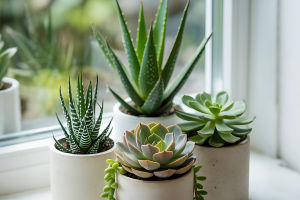If you've ever seen a leaf chewed up overnight or a flower wilt for no clear reason, you might think plants are helpless victims of the natural world. But here's something that might surprise you: plants have their own immune system.
They can sense attackers, respond with chemical weapons, and even "warn" their neighbors of incoming threats. Though they lack nerves or blood, their defense system is surprisingly sophisticated—and smarter than we often give them credit for.
So how exactly does a plant protect itself against insects, bacteria, fungi, and other invaders?
Built-In Defenses: First Line of Protection
Before a plant even notices an invader, it already has physical barriers in place. These passive defenses help prevent most attacks before they even start.
1. Waxy Cuticle: This thin, waxy layer on leaves acts like a raincoat, keeping out waterborne pathogens.
2. Thick Cell Walls: Plant cells are surrounded by tough walls that limit the spread of infections.
3. Trichomes: These tiny hair-like structures can poke or irritate small herbivores. Some trichomes even release toxic or sticky substances to trap insects.
But if something gets past these barriers—say, a caterpillar starts chewing or a fungus slips into a gap—plants don't just stay passive.
The Immune Response: Plants Can Sense Trouble
Plants have no brain or nerves, yet they're able to detect microbial invaders or insect damage almost immediately. They do this through receptor proteins on their cell surfaces.
Here's how it works:
1. Pattern Recognition: When a fungus or bacterium enters the plant, molecules on the invader's surface (called PAMPs, or pathogen-associated molecular patterns) are recognized by the plant's receptors.
2. Alarm Activation: The plant activates a rapid defense response, including producing antimicrobial chemicals, reinforcing cell walls, and in some cases, causing programmed cell death in infected cells to contain the spread—like sacrificing a few cells to save the whole leaf.
3. Systemic Alert: In many cases, the plant will send internal signals to warn distant parts of its own body—or even nearby plants—that danger is present.
When Invaders Outsmart the Plant
Some pathogens and insects evolve ways to sneak past this system. For example, they may produce special proteins that suppress the plant's early immune responses.
To counter this, plants have a second line of defense: Effector-Triggered Immunity (ETI).
In ETI, the plant uses specific internal sensors (often encoded by R genes) to detect invader proteins inside its own cells. When these are triggered, the plant responds with a stronger, more targeted defense—often causing a hypersensitive reaction where infected cells die off quickly to trap the pathogen.
ETI is slower but more precise. It's somewhat comparable to our body's adaptive immune system, which learns from previous infections.
Defense Chemicals: Nature's Homemade Pesticides
Plants produce a wide range of secondary metabolites—compounds not involved in basic growth, but used purely for defense.
Some of the most fascinating include:
1. Alkaloids: These bitter-tasting compounds (found in nightshade, and others) can interfere with insect nervous systems.
2. Terpenoids: These include essential oils like menthol or limonene, which deter insects or attract predators of the attacking insect.
3. Phenolics: These include tannins and lignin—used to strengthen cell walls and make plant tissue less digestible.
These chemicals aren't stored randomly. Some are produced only in response to damage, to conserve energy and avoid unnecessary self-toxicity.
Plant "Communication": Warnings and Signals
Perhaps most mind-blowing is that plants warn each other when under attack.
Take jasmonic acid, for example—a plant hormone released into the air when a leaf is wounded by an insect. Neighboring plants can detect this airborne signal and begin ramping up their own chemical defenses before being attacked.
There's also electrical signaling within a plant. Research published in Science (Toyota et al., 2018) found that when a leaf is bitten, an electrical wave (similar to nerve impulses) travels through the plant, activating defense responses in distant areas.
So, even though plants don't "feel pain" as animals do, they do recognize damage and respond with highly organized signals.
Real-World Uses: How This Knowledge Helps Us
Understanding plant immunity isn't just academic—it has real-life applications in agriculture, gardening, and sustainability.
1. Natural Pest Resistance: Breeders can select or genetically enhance crops with stronger ETI responses, reducing the need for pesticides.
2. Biological Control: Farmers can introduce beneficial microbes that "train" a plant's immune system to respond faster.
3. Smarter Gardening: Gardeners can choose companion plants that release helpful signals or compounds, creating a kind of neighborhood immunity.
And if you've ever used neem oil or garlic spray in your backyard garden, you've already taken advantage of plant defense chemistry—just from the outside in.
Seeing Plants as Fighters
The next time you see a leafy green thriving in the sun, remember—it's not just growing, it's also defending. Every day, silently, without moving an inch, that plant is making decisions: what to absorb, what to ignore, what to fight, and when to send out chemical cries for help.
Ever had a houseplant recover from a pest problem without any help? Chances are, it fought back on its own.
So, which plants in your space are the silent warriors? You might be living with more resilient fighters than you thought.


